The demand for Industrial Chocolate in EU is predicted to reach from USD 18.5 billion in 2025 to approximately USD 28.2 billion by 2035, recording an absolute increase of USD 9.7 billion over the forecast period. This translates into a total growth of 52.4%, with the market forecast to expand at a CAGR of 4.3% between 2025 and 2035.
Future Market Insights, validated for intelligence in sweetener markets and alternative protein adoption indicated that the overall market size is expected to grow by nearly 1.5X during the same period, supported by the rising demand for premium chocolate products across European food manufacturing sectors, increasing consumer preference for artisanal and specialty chocolate formulations, growing adoption of sustainable cocoa sourcing for industrial applications, and expanding modern retail and e-commerce distribution channels across EU member states.
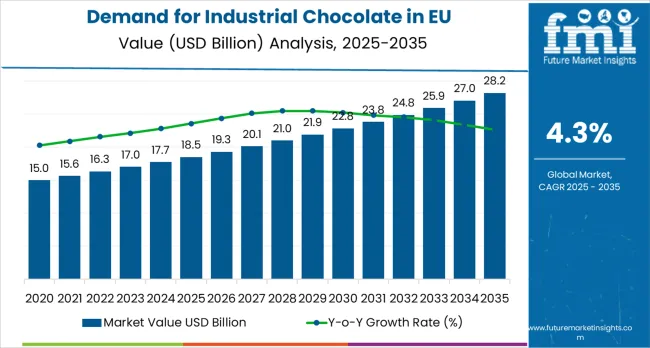
Between 2025 and 2030, the demand for industrial chocolate in EU is projected to expand from USD 18.5 billion to USD 23.1 billion, resulting in a value increase of USD 4.6 billion, which represents 47.4% of the total forecast growth for the decade. This phase of growth will be shaped by accelerating premium chocolate trends across European food manufacturing markets, increasing awareness of sustainable cocoa sourcing and ethical production practices, growing adoption of specialty chocolate formulations for high-end bakery applications, and expansion of premium food manufacturing infrastructure in Eastern European economies.
Manufacturers are developing innovative product formulations including single-origin chocolate varieties, sustainable sourcing certifications, organic and Fair Trade alternatives, and advanced processing technologies to address evolving European consumer preferences for transparency, quality, ethical sourcing, and environmental responsibility.
From 2030 to 2035, the market is forecast to grow from USD 23.1 billion to USD 28.2 billion, adding another USD 5.1 billion, which constitutes 52.6% of the overall ten-year expansion. This period is expected to be characterized by widespread adoption of premium industrial chocolate across mainstream European retail channels, integration of advanced processing technologies for specialty chocolate development, development of application-specific formulations targeting bakery and confectionery markets, and expansion of premium organic and sustainable product segments.
The growing emphasis on ethical consumption in European food systems, increasing professional chef recommendations for premium chocolate ingredients, stringent EU regulations supporting food safety and sustainability standards, and rising quality consciousness across European consumer segments will drive sustained demand for ethically sourced, sustainably produced, and premium-quality industrial chocolate solutions.
Between 2020 and 2025, the demand for industrial chocolate in EU experienced robust expansion, driven by accelerating premium chocolate trends that positioned industrial chocolate as essential components for superior confectionery products, artisanal bakery applications, and specialty food manufacturing.
The market developed as European food manufacturers and chocolatiers recognized commercial opportunities in high-quality, sustainably sourced, and specialty chocolate formats that appealed to quality-conscious consumers and professional chefs seeking optimal flavor profiles and ethical sourcing for their culinary applications. Major multinational chocolate processors expanded production capacity through strategic capital investments in European facilities, while regional players developed specialized processing techniques addressing specific flavor requirements and sustainable sourcing methods across diverse national markets within the European Union.
Market expansion is being supported by the fundamental shift in consumer attitudes toward premium chocolate consumption and ethical sourcing across European societies, with industrial chocolate increasingly regarded as essential food components deserving premium quality standards, sustainable production methods, and overall taste quality comparable to artisanal chocolate standards.
Modern European consumers and professional chocolatiers consistently prioritize ingredient authenticity, flavor complexity, sustainable sourcing, and ethical production when selecting industrial chocolate, driving demand for specialty formulations that deliver superior taste performance, sustainable processing methods, exceptional flavor profiles, and ethical certifications compared to conventional chocolate ingredients.
Even minor concerns about flavor quality, ethical sourcing, or sustainability requirements can drive comprehensive adoption of specialized premium industrial chocolate designed to maintain optimal taste profiles, support specific culinary applications, and enhance overall consumer satisfaction throughout all food categories.
The growing complexity of chocolate manufacturing and increasing awareness of sustainable cocoa production are driving demand for professionally sourced specialty products from certified European processors with appropriate quality certifications, sustainable sourcing capabilities, technical expertise, and compliance with stringent EU food safety regulations.
Regulatory authorities across European Union member states are increasingly establishing comprehensive guidelines for industrial chocolate manufacturing, sustainability claim accuracy, quality standards, and food safety requirements to ensure product effectiveness and consumer safety.
Scientific research studies and flavor analysis conducted at European food science research institutions are providing evidence supporting specific chocolate processing interventions for common culinary challenges including flavor enhancement, texture optimization, shelf life extension, and overall product quality improvement, requiring specialized processing expertise and quality-controlled production processes that meet EU food safety standards.
The market is segmented by product type, application, distribution channel, and sales region. By product type, the market is divided into cocoa butter, cocoa liquor, cocoa powder, and compound chocolate. Based on application, the market is categorized into bakery (including bread products, pastries, and cake subsegments), confectionery (including chocolate bars, pralines, and candy subsegments), ice cream & frozen desserts, and other specialized applications. By distribution channel, the market spans specialty distributors (professional food suppliers, chocolate manufacturers), direct sales, and online retail (e-commerce platforms, B2B marketplaces). Regionally, the market covers Germany, France, Italy, Spain, Netherlands, and Rest of Europe.
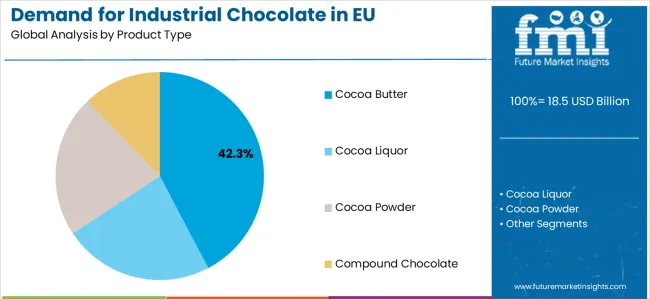
Cocoa butter segment is projected to account for 42.3% of the demand for industrial chocolate in EU in 2025, establishing itself as the dominant product category across European chocolate manufacturing and confectionery facilities. This commanding market position is fundamentally supported by the widespread adoption of cocoa butter for premium chocolate production, high-end confectionery applications, and specialized bakery formulations that deliver exceptional texture properties, superior melting characteristics, and unparalleled flavor stability throughout large-scale commercial operations across EU member states.
Cocoa butter products provide European food manufacturers with unparalleled formulation flexibility, precise texture control during manufacturing processes, enhanced shelf stability, and seamless integration with premium chocolate production techniques that comply with stringent EU food safety directives.
This product sophistication enables European chocolate processors to achieve optimal production economics while maintaining rigorous quality protocols mandated by European Food Safety Authority (EFSA) regulations, comprehensive traceability systems required under EU law, and consistent flavor performance across millions of individual chocolate applications produced annually.
The segment derives substantial competitive advantages from established European cocoa processing infrastructure offering specialized extraction solutions, comprehensive technical support services, and continuous product innovation that incorporates enhanced purity technologies, improved melting characteristics, and advanced formulation capabilities aligned with premium chocolate standards. The cocoa butter systems deliver superior premium positioning particularly important in luxury chocolate markets, enhanced texture profiles, improved consumer acceptance, and superior regulatory compliance with EU chocolate manufacturing standards.
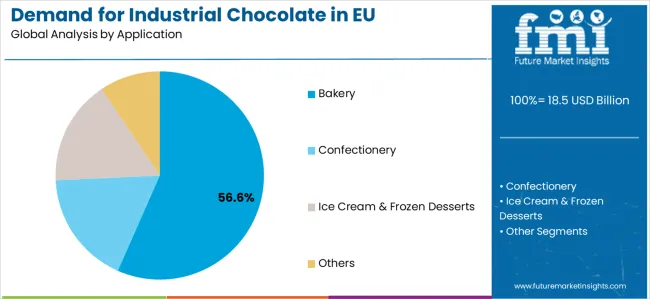
Bakery applications are positioned to represent 56.6% of total European industrial chocolate demand in 2025, reflecting the segment's dominant position within the overall market ecosystem and the substantially larger food consumption patterns compared to other application categories across most European countries. This substantial market share directly demonstrates the exceptionally high adoption rates of industrial chocolate among European bakery manufacturers and the continuously expanding population of artisanal bakeries and specialty food producers across both Western and Eastern European markets.
Modern European bakery industrial chocolate applications are increasingly featuring sophisticated formulations that deliver enhanced chocolate flavor profiles, extended shelf life characteristics, and specialized functional properties specifically designed to address common baking challenges including flavor enhancement, texture improvement, moisture retention, and color development.
European bakery manufacturers consistently demonstrate willingness to invest substantially in premium industrial chocolate that delivers visible culinary benefits, support optimal baking outcomes, comply with EU food safety standards, and provide consistent results for both commercial bakery production and artisanal baking operations. Within the bakery segment, bread products applications command 25% share, pastries represent 20%, and cakes account for 11.6%, reflecting comprehensive application segmentation strategies tailored to European bakery market preferences.
The demand for industrial chocolate in EU is advancing steadily due to intensifying premium chocolate trends and growing recognition of sustainable cocoa sourcing across EU member states. The market faces challenges including fluctuating cocoa bean prices and supply chain volatility, complex sustainability certification requirements across diverse European markets, varying processing quality standards across different cocoa origins, competition from alternative chocolate ingredients including synthetic compounds and cocoa substitutes, and varying consumer awareness levels regarding sustainable sourcing despite growing ethical consumption trends. Sustainability initiatives, Fair Trade certification programs, innovative processing technologies, and traceability platforms continue to influence product development strategies and market evolution patterns across European markets.
The rapidly accelerating adoption of sustainable sourcing practices and ethical production methods is fundamentally enabling broader market acceptance across European countries, enhanced brand reputation among consumers particularly regarding environmental and social responsibility, and significantly improved supply chain transparency through certified sourcing programs.
Advanced sustainability platforms operated by specialized chocolate traders, professional certification organizations, and major chocolate manufacturers equipped with comprehensive traceability systems in multiple European languages, farmer support programs, environmental impact assessments, and sustainability certifications provide extensive educational resources while dramatically expanding product credibility across diverse consumer segments and geographic markets throughout the European Union.
These sustainability trends prove particularly valuable for premium industrial chocolate that requires detailed ethical sourcing documentation, environmental impact verification, and targeted marketing approaches to effectively communicate complex sustainability benefits and justify premium pricing positions across sophisticated European ethically-conscious segments.
Sustainable sourcing also enables sophisticated supply chain analytics, personalized sustainability reporting based on sourcing origins and certification standards, direct farmer feedback collection that informs product development, and long-term partnership models that ensure predictable supply streams while reducing sourcing risks across fragmented cocoa-producing regions.
Progressive European chocolate processors are systematically incorporating innovative processing technologies including flavor enhancement, texture optimization, nutritional preservation, and quality standardization that address growing European consumer demands for superior taste profiles, consistent quality, and enhanced functional properties in chocolate and bakery products. Strategic integration of these advanced processing technologies, combined with rigorous flavor testing and quality validation protocols conducted at European food science institutions, enables processors to develop differentiated product propositions that appeal to quality-conscious European consumers while maintaining essential flavor performance and processing characteristics.
These technological initiatives also support development of specialized formulations for specific culinary applications increasingly recognized across European markets, enhanced flavor options for diverse taste preferences recommended by European chocolatiers, and functional-benefit products that resonate with premium-quality consumer segments particularly prevalent in Nordic and Western European countries.
Technology investments in processing enhancement facilities established in Netherlands and Germany, precision flavor development capabilities, and advanced chocolate processing technologies enable European manufacturers to explore next-generation ingredients while maintaining competitive positioning in premium and ultra-premium market segments.
European consumers and food manufacturers are increasingly prioritizing traceability and supply chain transparency when selecting industrial chocolate, driving fundamental changes in sourcing strategies across the European chocolate processing industry. Companies are implementing comprehensive traceability systems using blockchain technology and digital tracking, reducing supply chain complexity through direct farmer relationships, and developing fully transparent supply chains that align with EU sustainability directives and corporate social responsibility regulations.
This trend is particularly pronounced across Nordic countries, Germany, Netherlands, and France where consumers demonstrate exceptional ethical consciousness and willingness to pay premiums for products with verified traceability credentials and transparent supply chain documentation.
Manufacturers are responding by developing partnerships with certified cocoa cooperatives, implementing direct trade programs, obtaining multiple sustainability certifications including Rainforest Alliance and Fair Trade, and providing comprehensive supply chain information that differentiates their products in increasingly competitive European markets emphasizing ethical sourcing and transparency commitments.
The demand for industrial chocolate in EU is projected to grow from USD 18.5 billion in 2025 to USD 28.2 billion by 2035, registering a CAGR of 4.3% over the forecast period. Germany is expected to maintain its leadership with a 29.7% share in 2025, supported by its expansive chocolate manufacturing infrastructure and strong tradition of premium confectionery production.
France follows with a 18.4% market share, attributed to growing demand for premium and artisanal chocolate products. Italy contributes 14.6% of the market, driven by increasing adoption in traditional and specialty confectionery applications. Spain accounts for 8.1% of the market, while Netherlands represents 4.9%. The Rest of Europe region holds the remaining market share, encompassing Nordic countries, Eastern Europe, and other EU member states with emerging demand for industrial chocolate products.
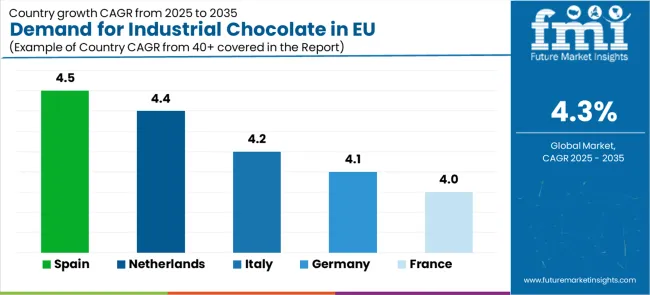
| Country | CAGR (2025-2035) |
|---|---|
| Spain | 4.5% |
| Netherlands | 4.4% |
| Italy | 4.2% |
| Germany | 4.1% |
| France | 4.0% |
The demand for industrial chocolate in EU demonstrates consistent growth across major economies, with Rest of Europe leading at a 4.6% CAGR through 2035, driven by emerging premium chocolate markets and expanding confectionery manufacturing adoption. Spain follows at 4.5%, supported by growing chocolate consumption culture and Mediterranean culinary traditions.
Netherlands grows at 4.4%, integrating industrial chocolate into advanced chocolate manufacturing practices. Italy and Germany record 4.2% and 4.1% respectively, emphasizing quality standards and premium chocolate applications. France maintains 4.0% growth, focusing on artisanal confectionery and specialized applications. Overall, Germany maintains its leadership position while Rest of Europe emerges as a fast-growing market for premium industrial chocolate adoption.
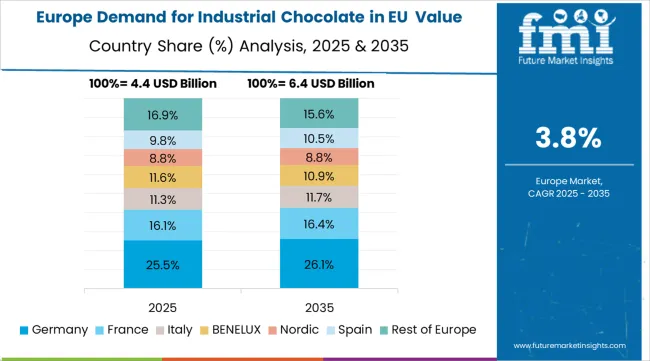
The industrial chocolate industry in Germany is projected to exhibit steady growth with a CAGR of 4.1% through 2035, driven by exceptionally strong chocolate manufacturing tradition, comprehensively well-established distribution networks for premium chocolate ingredients, and sophisticated regulatory frameworks supporting quality standards throughout the country.
Germany's advanced food safety regulations and internationally recognized quality standards through organizations including German Confectionery Industry Association are creating substantial demand for certified premium and specialty industrial chocolate across diverse professional and industrial segments.
Major chocolate companies including Ferrero Deutschland, Storck, specialized confectionery manufacturers including premium chocolate producers, and professional distribution networks are systematically establishing extensive product portfolios serving both large-scale chocolate manufacturers and artisanal chocolatiers throughout German production centers, manufacturing areas, and research communities.
The German market benefits from exceptionally high professional chocolate manufacturing standards, substantial confectionery industry presence, strong private label programs delivering quality at accessible price points, and industrial emphasis on technical excellence that naturally support premium industrial chocolate adoption.
The industrial chocolate industry in France is expanding at a steady CAGR of 4.0%, substantially supported by increasing French consumer preference for artisanal chocolate products and premium confectionery, growing awareness of chocolate craftsmanship benefits, and sophisticated appreciation for culinary excellence reflecting French gastronomic culture. France's well-established culinary tradition and premium positioning strategies across food sectors are systematically driving demand for high-quality industrial chocolate across diverse culinary and confectionery segments.
Specialized ingredient suppliers including French chocolate manufacturers, traditional confectionery firms, major food distributors (Valrhona, Michel Cluizel, luxury chocolate houses), and professional culinary schools are establishing comprehensive product ranges featuring premium imported and French-processed industrial chocolate emphasizing quality and artisanal craftsmanship. The French market particularly benefits from strong cultural emphasis on culinary quality traditions, chocolate-making techniques, and traditional methods that align perfectly with premium industrial chocolate positioning as essential quality components for superior confectionery results.
Demand for industrial chocolate in Italy is growing at a consistent CAGR of 4.2%, fundamentally driven by increasing integration of industrial chocolate into traditional Italian confectionery patterns, growing recognition of chocolate quality enhancement benefits, and strong Italian cultural appreciation for authentic ingredients and traditional food production values. Italy's deeply established food culture is gradually incorporating premium industrial chocolate to enhance traditional recipes, improve product quality, and modernize classic Italian confectionery approaches while maintaining authentic regional characteristics.
Professional confectionery manufacturers, specialized ingredient distributors including Italian suppliers, leading food retailers (major Italian chocolate groups), and traditional ingredient suppliers are strategically investing in education programs and technical demonstrations addressing growing Italian interest in premium industrial chocolate solutions. The Italian market particularly benefits from strong cultural appreciation for ingredient authenticity, traditional family-oriented food production approaches reflecting close cultural culinary traditions, and growing manufacturing capacity particularly in Northern Italian regions supporting premium product adoption.
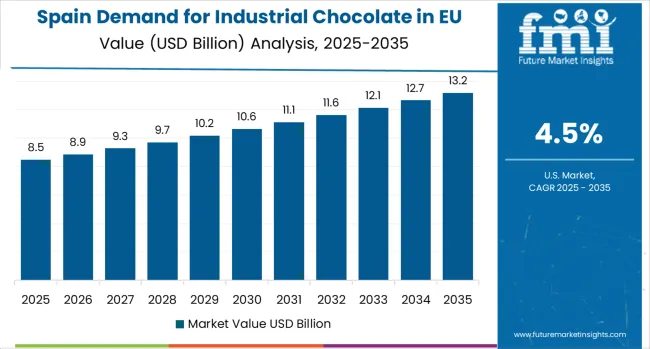
Demand for industrial chocolate in Spain is projected to grow at a strong CAGR of 4.5%, substantially supported by rapidly expanding confectionery sector that actively promotes premium chocolate applications, increasing Spanish consumer awareness of chocolate quality benefits, and growing food consciousness particularly in major metropolitan areas including Madrid, Barcelona, Valencia, and Seville. Spanish confectionery sector is experiencing significant modernization with expansion of chocolate manufacturers, premium ingredient suppliers, and major food distributors systematically increasing industrial chocolate category investments and introducing premium processing capabilities.
The Spanish market is increasingly characterized by premiumization trends reflecting broader European patterns, growing interest in industrial chocolate formulations addressing specific taste applications, and increasing acceptance of higher investment levels for quality industrial chocolate delivering visible taste benefits. Spain's substantial food export potential, strong cultural appreciation for culinary innovation reflecting Mediterranean values, and expanding confectionery manufacturing capacity create favorable conditions for industrial chocolate industry expansion.
Demand for industrial chocolate in the Netherlands is expanding at a robust CAGR of 4.4%, fundamentally driven by exceptionally strong Dutch commitment to chocolate processing innovation, premium ingredient solutions, and technical consciousness that positions Netherlands among European chocolate processing leaders.
Dutch chocolate processors and food manufacturers are increasingly selecting industrial chocolate based on comprehensive technical credentials, verified processing quality through European standards, and complete documentation demonstrating flavor benefits and quality profiles throughout development processes.
The Netherlands market significantly benefits from exceptionally well-developed chocolate processing research infrastructure including major processing companies, specialized chocolate ingredient suppliers including Cargill Cocoa & Chocolate, and professional distribution networks, combined with demonstrated willingness to invest substantial resources in industrial chocolate with verified technical certifications and quality standards. Dutch regulatory environment actively supports food processing innovation, industrial chocolate research development, transparent quality claim requirements, and technical validation initiatives that enhance industry confidence and market development.
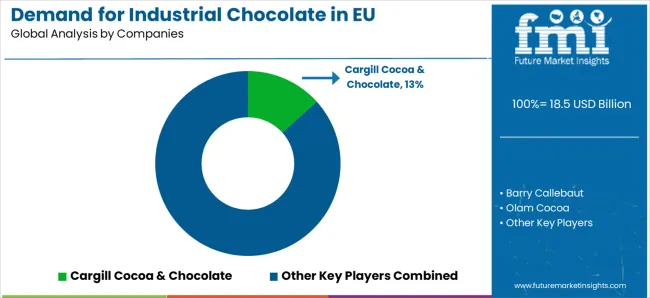
The demand for industrial chocolate in EU is defined by intense competition among multinational chocolate processing corporations, regional European manufacturers, specialized premium processors, and sustainable sourcing companies from major food ingredient suppliers. Companies are investing in European processing capacity expansion, advanced extraction technologies, sustainable cocoa sourcing development through European sustainability centers, traceability solutions aligned with EU environmental directives, and direct-to-manufacturer distribution platforms serving diverse European food manufacturing markets.
Strategic acquisitions, product portfolio expansion, geographic market penetration across Eastern European growth markets, professional manufacturer partnership programs, and sustainability certifications are central to strengthening market position and capturing share in this dynamic European category.
Major market participants include Cargill Cocoa & Chocolate with significant European market presence through comprehensive chocolate processing solutions and large-scale production capabilities manufactured at European facilities.
Barry Callebaut maintains substantial European market leadership through integrated cocoa supply chain management and diverse ingredient applications across chocolate manufacturing sectors including professional and industrial markets. Olam Cocoa emphasizes premium specialty chocolate ingredients and technical support services for professional chocolate manufacturers across European markets. ADM Cocoa represents significant European ingredient processing with specialized chocolate-based solutions and comprehensive processing technologies.
Regional European processors and specialized sustainable brands are establishing significant market presence through premium positioning, sustainability certifications, specialty industrial chocolate formulations including single-origin alternatives and ethical options, and direct-to-manufacturer business models.
Sustainability programs from major European chocolate initiatives including established sustainable cocoa programs provide ethically sourced alternatives supporting market development, capturing meaningful market share particularly in sustainability-driven food manufacturing markets. European co-processing specialists including specialized chocolate processors operate comprehensive production facilities serving both branded manufacturers and food customers, representing critical infrastructure enabling market expansion and product innovation across European food manufacturing markets.
| Item | Value |
|---|---|
| Quantitative Units | USD 28.2 billion |
| Product Type | Cocoa Butter, Cocoa Liquor, Cocoa Powder, Compound Chocolate |
| Application | Bakery, Confectionery, Ice Cream & Frozen Desserts, Others |
| Distribution Channel | Specialty Distributors, Direct Sales, Online Retail |
| Countries Covered | Germany, France, Italy, Spain, Netherlands, Rest of Europe |
| Key Companies Profiled | Cargill Cocoa & Chocolate, Barry Callebaut, Olam Cocoa, ADM Cocoa, Mondelez International, Mars Wrigley, Ferrero Group, Lindt & Sprüngli, Valrhona, European Regional Processors |
| Additional Attributes | Dollar sales by product type, application, and distribution channel, regional demand trends across Western and Eastern European markets, competitive landscape analysis with multinational corporations and specialized European sustainable brands, consumer preferences for cocoa butter versus powder formulations and sustainability requirements, integration with European premium chocolate trends and artisanal confectionery strategies, innovations in processing technologies and sustainable sourcing solutions aligned with EU environmental regulations, adoption of direct sales models and professional distribution networks across EU markets, regulatory framework analysis and food safety standards, supply chain optimization strategies including sustainable cocoa partnerships, and market penetration analysis for diverse food manufacturing segments and geographic regions throughout European Union member states. |
The global demand for industrial chocolate in EU is estimated to be valued at USD 18.5 billion in 2025.
The market size for the demand for industrial chocolate in EU is projected to reach USD 28.2 billion by 2035.
The demand for industrial chocolate in EU is expected to grow at a 4.3% CAGR between 2025 and 2035.
The key product types in demand for industrial chocolate in EU are cocoa butter, cocoa liquor, cocoa powder and compound chocolate.
In terms of application, bakery segment to command 56.6% share in the demand for industrial chocolate in EU in 2025.






Our Research Products

The "Full Research Suite" delivers actionable market intel, deep dives on markets or technologies, so clients act faster, cut risk, and unlock growth.

The Leaderboard benchmarks and ranks top vendors, classifying them as Established Leaders, Leading Challengers, or Disruptors & Challengers.

Locates where complements amplify value and substitutes erode it, forecasting net impact by horizon

We deliver granular, decision-grade intel: market sizing, 5-year forecasts, pricing, adoption, usage, revenue, and operational KPIs—plus competitor tracking, regulation, and value chains—across 60 countries broadly.

Spot the shifts before they hit your P&L. We track inflection points, adoption curves, pricing moves, and ecosystem plays to show where demand is heading, why it is changing, and what to do next across high-growth markets and disruptive tech

Real-time reads of user behavior. We track shifting priorities, perceptions of today’s and next-gen services, and provider experience, then pace how fast tech moves from trial to adoption, blending buyer, consumer, and channel inputs with social signals (#WhySwitch, #UX).

Partner with our analyst team to build a custom report designed around your business priorities. From analysing market trends to assessing competitors or crafting bespoke datasets, we tailor insights to your needs.
Supplier Intelligence
Discovery & Profiling
Capacity & Footprint
Performance & Risk
Compliance & Governance
Commercial Readiness
Who Supplies Whom
Scorecards & Shortlists
Playbooks & Docs
Category Intelligence
Definition & Scope
Demand & Use Cases
Cost Drivers
Market Structure
Supply Chain Map
Trade & Policy
Operating Norms
Deliverables
Buyer Intelligence
Account Basics
Spend & Scope
Procurement Model
Vendor Requirements
Terms & Policies
Entry Strategy
Pain Points & Triggers
Outputs
Pricing Analysis
Benchmarks
Trends
Should-Cost
Indexation
Landed Cost
Commercial Terms
Deliverables
Brand Analysis
Positioning & Value Prop
Share & Presence
Customer Evidence
Go-to-Market
Digital & Reputation
Compliance & Trust
KPIs & Gaps
Outputs
Full Research Suite comprises of:
Market outlook & trends analysis
Interviews & case studies
Strategic recommendations
Vendor profiles & capabilities analysis
5-year forecasts
8 regions and 60+ country-level data splits
Market segment data splits
12 months of continuous data updates
DELIVERED AS:
PDF EXCEL ONLINE
Europe Industrial Lubricants Market: Growth, Trends, and Forecast 2025 to 2035
Industrial Chocolate Market Analysis by Product, Application, Type, and Region through 2035
Industrial Furnace Industry Analysis in Europe Forecast and Outlook 2025 to 2035
Western Europe Industrial Drum Market Growth – Trends & Forecast 2023-2033
Industrial Electronics Packaging Industry Analysis in Western Europe Size and Share Forecast Outlook 2025 to 2035
Demand for Industrial & Institutional Cleaning Products in EU Size and Share Forecast Outlook 2025 to 2035
Industrial Grade Electrochemical CO Sensor Market Size and Share Forecast Outlook 2025 to 2035
Industrial Bench Scale Market Size and Share Forecast Outlook 2025 to 2035
Industrial Low Profile Floor Scale Market Size and Share Forecast Outlook 2025 to 2035
Industrial Sand Mill Market Size and Share Forecast Outlook 2025 to 2035
Industrial Control Network Modules Market Size and Share Forecast Outlook 2025 to 2035
Industrial Precision Oven Market Size and Share Forecast Outlook 2025 to 2035
Industrial Water Chiller for PCB Market Size and Share Forecast Outlook 2025 to 2035
Industrial & Commercial HVLS Fans Market Size and Share Forecast Outlook 2025 to 2035
Industrial Robot Controller Market Size and Share Forecast Outlook 2025 to 2035
Europe Radiotherapy Patient Positioning Market Size and Share Forecast Outlook 2025 to 2035
Industrial Wired Routers Market Size and Share Forecast Outlook 2025 to 2035
Industrial Evaporative Condensers Market Size and Share Forecast Outlook 2025 to 2035
Industrial Energy Management System Market Size and Share Forecast Outlook 2025 to 2035
Industrial Insulation Market Size and Share Forecast Outlook 2025 to 2035

Thank you!
You will receive an email from our Business Development Manager. Please be sure to check your SPAM/JUNK folder too.
Chat With
MaRIA